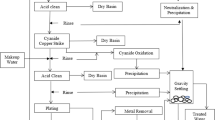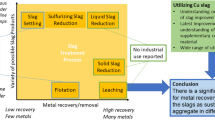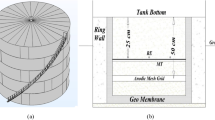Abstract
The present study describes the biocorrosion of mild steel (MS1010) and pure copper (Cu) in cooling water environments (both field and lab study). Electrochemical and surface analyses of both metals were carried out to confirm the corrosion susceptibility in the presence of bacteria and inhibitor. Surface analysis of the MS and Cu coupons revealed that biofilm was developed with increasing exposure time in the field study. In the lab study, accumulation of extracellular polymeric substance over the metal surface was noticed and led to the severe pitting type of corrosion on both metal surfaces. Besides, the anti-corrosive study was carried out using the combinations of commercial corrosion inhibitor (S7653—10 ppm) with biocide (F5100—5 ppm), and the results reveal that the corrosion rate of MS and Cu was highly reduced to 0.0281 and 0.0021 mm/year (inhibitor system) than 0.1589 and 0.0177 mm/year (control system). Inhibition efficiency for both metals in the presence of inhibitor with biocide was found as 82 and 88% for MS and Cu, respectively. The present study concluded that MS was very susceptible to biocorrosion, compared to copper metal in cooling water environment. Further, the combination of the both inhibitor and biocide was effectively inhibiting the biocorrosion which was due to its antibacterial and anti-corrosive properties.




Similar content being viewed by others
References
Baars JK (1930) Over sulfaatreductie door bacteria in. Ph.D. thesis, University of Delft
Beech IB, Gaylarde CC (1999) Recent advance in the study of biocorrosion—an overview. Rev Microb 30:177–190
Booth GH (ed) (1971) Microbiological corrosion, M and B monographs CE11. Mills and Boon, London
ColomboL A, Trasatt OSP (2018) Corrosion failure analysis of galvanized steel pipes in a closed water cooling system. Eng Fail Anal 84:46–58
De la Fuente D, Diaz I, Simancas J, Chico B, Morcillo M (2011) Long term atmospheric corrosion of mild steel. Corros Sci 53:604–617
El-Shamy AM, Soror TY, El-Dahan HA, Ghazy EA, Eweas AF (2009) Microbial corrosion inhibition of mild steel in salty water environment. Mater Chem Phys 114:156–159
Flemming HC (1996) Economical and technical overview. In: Heitz E, Lemming H-C, Sand W (eds) Microbially influenced corrosion of materials. Springer, Heidelberg
Fonseca ITE, Picciochi R, Mendonca MH, Ramos AC (2004) The atmospheric corrosion of copper at two sites in Portugal: a comparative study. Corros Sci 46:547–561
Fontana MG (1986) Corrosion engineering. Mc-Graw Hill, New York
Harrah T, Panilaitis B, Kaplan D (2004) Microbial exopolysaccharides. In: Dworkin M, Falkow S, Rosenberg E, Schleifer KH, Stackebrandt E (eds) The prokaryotes. Springer, New York, pp 88–115
Hassan N, Holze R (2009) A comparative electrochemical study of electrosorbed 2- and 4-mercaptopyridines and their application as corrosion inhibitors at C60 steel. J Chem Sci 121:753–781
Jayaraman A, Earthman JC, Wood TK (1997) Corrosion inhibition by aerobic biofilms on SAE 1018 steel. Appl Microbiol Biotechnol 52:267–275
Jones DA, Amy PS (2000) Related electrochemical characteristics of microbial metabolism and iron corrosion. Ind Eng Chem Res 39:575–582
Kamal C, Sethuraman MG (2013) Kappaphycus alvarezii—a marine red alga as a green inhibitor for acid corrosion of mild steel. Mate Corros 64:9999
Ma Y, Li Y, Wang F (2000) Weatherability of 09CuPCrNi steel intropical marine environment. Corros Sci 51:1725–1732
MacDonald R, Brözel VS (2000) Community analysis of bacterial biofilms in a simulated recirculating cooling-water system by fluorescent in situ hybridization with rRNA-targeted oligonucleotide probes. Water Res 34:2439–2446
Martinez SS, Gallegos AA, Martinez E (2004) Electrolytically generated silver and copper ions to treat cooling water: an environmentally friendly novel alternative. Int J Hydrog Eng 29:921–932
NACE-RP0775 (2005) Standard recommended practice: preparation, installation, analysis, and interpretation of corrosion coupons in oilfield operations. NACE International, Houston, TX
Narenkumar J, Madhavan J, Nicoletti M, Benelli G, Murugan K, Rajasekar A (2016) Role of bacterial plasmid on biofilm formation and its influence on corrosion of engineering materials. J Bio Tribo Corros 2:24
Narenkumar J, Parthipan P, Nanthini AUR, Benelli G, Murugan K, Rajasekar A (2017a) Ginger extract as green biocide to control microbial corrosion of mild steel. 3 Biotech 7:133. https://doi.org/10.1007/s13205-017-0783-9
Narenkumar J, Sathishkumar K, Selvi A, Gobinath R, Murugan K, Rajasekar A (2017b) Role of calcium depositing bacteria Agrobacterium tumefaciens and its influence on corrosion of different engineering metals used in cooling water system. 3 Biotech 7:374
Narenkumar J, Parthipan P, Madhavan J, Murugan K, Suresh A, Rajasekar A (2017c) Bio-engineered silver nanoparticles: potent anti-corrosive inhibitor against corrosion of mild steel in cooling towers. Environ Sci Pollut Res. https://doi.org/10.1007/s11356-017-0768-6
Narenkumar J, Ramesh N, Rajasekar A (2018) Control of corrosive bacterial community by biocide bronopol in industrial water system. Biotech. https://doi.org/10.1007/s13205-017-1071-4
Obuekwe CO, Westlake DWS, Cook FD, Costerton JW (1981) Surface changes in mild steel coupons from the action of corrosion-causing bacteria. Appl Environ Microbiol 41:766
Odewunmi NA, Umoren SA, Gasem ZM (2015) Utilization of watermelon rind extract as a green corrosion inhibitor for mild steel in acidic media J Ind Eng Chem 21:239–247
Parthipan P, Ganesh Babu T, Anandkumar B, Rajasekar A (2017a) Biocorrosion and its impact on carbon steel API 5LX by Bacillus subtilis A1 and Bacillus cereus A4 isolated from crude oil reservoir, India. J Bio Tribo Corros 3:32. https://doi.org/10.1007/s40735-017-0091-2
Parthipan P, Narenkumar J, Elumalai P, Preethi PS, Nanthini AUR, Agrawal A, Rajasekar A (2017b) Neem extract as a inhibitor for microbiologically influenced corrosion of carbon steel API 5LX in a hypersaline environments. J Mol Liq 240:121–127. https://doi.org/10.1016/j.molliq.2017.05.059
Ping Xu (2012) MIC in circulating cooling water system. Water Res 4:203–206
Rahmani K et al (2015) Evaluation of inhibitors and biocides on the corrosion, scaling and biofouling control of carbon steel and copper–nickel alloys. Desalination. https://doi.org/10.1016/j.desal.2015.07.026
Rajasekar A, Ting YP (2011) Role of inorganic and organic medium in the corrosion behavior of Bacillus megaterium and Pseudomonas sp. in stainless steel SS 304. Ind Eng Chem Res 50:12534–12541
Rajasekar A, Ting YP (2014) Characterization of corrosive bacterial consortia isolated from water in a cooling tower. ISRN Corros 10:1155
Rajasekar A, Maruthamuthu S, Muthukumar N, Mohanan S, Subramanian P, Palaniswamy N (2005) Bacterial degradation of naphtha and its influence on corrosion. Corros Sci 47:257–271
Rajasekar A, Ganesh Babu T, Karutha Pandian S, Maruthamuthu S, Palaniswamy N, Rajendran A (2007) Biodegradation and corrosion behaviour of manganese oxidizer Bacillus cereus ACE4 in diesel transporting pipeline. Corros Sci 49:2694–2710
Rajasekar A, Maruthamuthu S, Ting YP (2008) Electrochemical behavior of Serratia marcescens ACE2 on carbon steel API 5L-X60 in organic/aqueous phase. Ind Eng Chem Res 47:7525–7532
Rajasekar A, Xiao W, Sethuraman M, Parthipan P, Elumalai P (2017) Airborne microorganisms associated with corrosion of structural engineering materials. Environ Sci Pollut Res. https://doi.org/10.1007/s11356-017-8501-z
Raoa TS, Sairam TN, Viswanathan B, Nair KVK (2000) Carbon steel corrosion by iron oxidising and sulphate reducing bacteria in a freshwater cooling system. Corros Sci 42:1417–1431
Shaily M, Bhola A, Faisal M, Alabbas A, Rahul Bhola A, John R, Spear B, Brajendra Mishra A, David L, Olson A, Anthony E, Kakpovbia C (2014) Neem extract as an inhibitor for biocorrosion influenced by sulfate reducing bacteria: a preliminary investigation. Eng Fail Anal 36:92–103
Shameer S (2016) Biosorption of lead, copper and cadmium using the extracellular polysaccharides (EPS) of Bacillus sp., from solar salterns. 3 Biotech 6:194
Wagner P, Little B (1993) Impact of alloying on microbiologically influenced corrosion a review. Mater Perform 32:65–68
Wang Z, Fan Z, Xie L, Wang S (2006) Study of integrated membrane systems for the treatment of wastewater from cooling towers. Desalination 191:117–124.
Wang J et al (2015) Hydroxyl carboxylate based non-phosphorus corrosion inhibition process for reclaimed water pipeline and downstream recirculating cooling water system. J Environ Sci 39:13–21
Zarasvand KA, Ravishankar Rai V (2016) Identification of the traditional and non-traditional sulfate-reducing bacteria associated with corroded ship hull. 3 Biotech 6:197
Author information
Authors and Affiliations
Corresponding authors
Ethics declarations
Ethical approval
This article does not contain any studies with human participants or animals performed by any of the authors.
Conflict of interest
The authors declare that they have no conflict of interest in the publication.
Electronic supplementary material
Below is the link to the electronic supplementary material.
Rights and permissions
About this article
Cite this article
Li, X.L., Narenkumar, J., Rajasekar, A. et al. Biocorrosion of mild steel and copper used in cooling tower water and its control. 3 Biotech 8, 178 (2018). https://doi.org/10.1007/s13205-018-1196-0
Received:
Accepted:
Published:
DOI: https://doi.org/10.1007/s13205-018-1196-0




